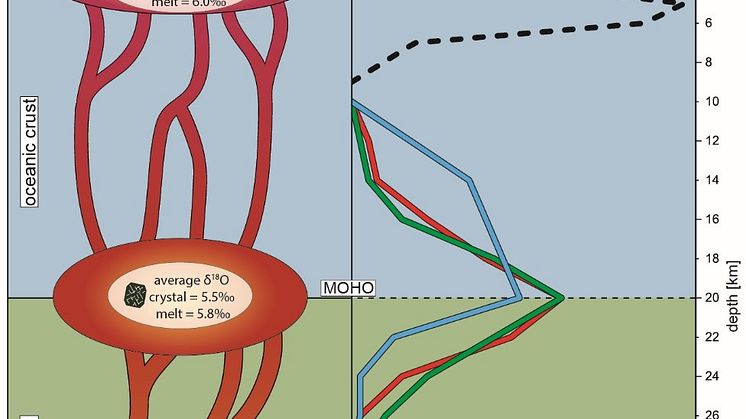Press release -
Magma storage and eruptive behaviour at Bali volcano
A new study by researchers at Uppsala University and the Italian National Institute for Geophysics and Volcanology (INGV) published in the journal Scientific Reports sheds light on magma storage under the currently active Agung volcano on the island of Bali in Indonesia. Magma at Agung is stored at both mantle (~20 km) and shallow crustal (~5 km) depths, which may be a potential cause for sudden pressure-driven eruptions in this densely populated part of the world.
In November 2017, Mount Agung on Bali erupted for the first time since 1963 and the activity is still ongoing as of July 2018. The ongoing activity at Agung is a source of worldwide interest, in part because Bali is an internationally beloved tourist destination and in part because of the destructive reputation of Indonesian volcanoes like Agung. Consider that the 1963 eruption of Agung was a major event where at least 1100 people died from fast flowing, glowing hot debris avalanches (pyroclastic flows) and the emission of sulphur gas to the stratosphere caused global temperatures to dip by 0.1 to 0.4 degrees Celsius. This volcano is a serious threat, but, thankfully, the 2017-2018 activity was not nearly as intense as the 1963 events. The recent activity did, however, lead to ash fall and evacuations of ca. 150,000 people and thousands of farm animals, flight disruptions, and widespread anxiety. Now that Agung volcano has shown signs of awakening, with ongoing ash eruptions at the time of writing (July 2018), it is imperative that we understand its inner workings as best we can. When it comes to understanding volcanoes, we can approach the topic a little like behavioral studies in that having a good handle on the volcano’s past behavior is the key to being prepared for its future activity.
The stories told by lava
The chemistry of the lavas from Agung and its “twin sister” Batur and the crystals within them revealed that preceding previous eruptions, magma was stored at multiple levels beneath the two volcanoes, likely within an interconnected network of melt pockets. One of the main storage levels was at the crust-mantle boundary some 20 km beneath the island’s surface. This is probably the region where fresh mantle-derived magma enters the crustal processing system. Fresh magma at depth can deliver new volume and heat as well as volatiles of H2O and CO2 to the volcanic system. In fact, it has been suggested that mantle magma replenishment was an important factor in driving the deadly 1963 eruption at Agung.
A shallow magma reservoir beneath Bali
The other major storage level detected at Agung lies within the top 5 km beneath the volcano. This is a crucial realization because when magma is stored in the top part of the Earth’s crust it cools and crystallizes, changing the composition of the remaining melt and enriching it in silica and volatiles like H2O. This is a recipe for explosive eruptions, as silica makes magma stickier and less likely to flow gently. Sticky magma also hinders the escape of volatiles to the surface, making the volcano more likely to “blow” rather than “flow” when it eventually erupts. Several magma storage levels would allow volatiles to concentrate and increase the pressure in the system. This can make volcanoes like Agung prone to blowing their top like a freshly opened soda bottle. This kind of magma storage system could therefore increase the potential for Agung to erupt explosively again in its future (as it did in 1963). This information is useful for local communities and officials to be aware of the nature of this hazard given that Bali is densely populated and a magnet for tourists who are drawn to its natural beauty.
This work was supported by the Swedish Research Council (Vetenskapsrådet).
Geiger, H., Troll, V.R., Jolis, E.M., Deegan, F.M., Harris, C., Hilton, D.R., Freda, C. (2018) Multi-level magma plumbing at Agung and Batur volcanoes increases risk of hazardous eruptions. Scientific Reports, in press. https://www.nature.com/articles/s41598-018-28125-2
For more information contact:
Harri Geiger, Doctoral/PhD student Department of Earth Sciences, Uppsala University, Uppsala, Sweden, harri.geiger@geo.uu.se
Professor Valentin R. Troll, Department of Earth Sciences, Uppsala University, Uppsala, Sweden, valentin.troll@geo.uu.se)
Frances M. Deegan, researcher Department of Earth Sciences, Uppsala University, Uppsala, Sweden, frances.deegan@geo.uu.se
Topics
Uppsala University -- quality, knowledge, and creativity since 1477
World-class research and outstanding education of global benefit to society, business, and culture.
Uppsala University is one of northern Europe's highest ranked academic institutions. www.uu.se


